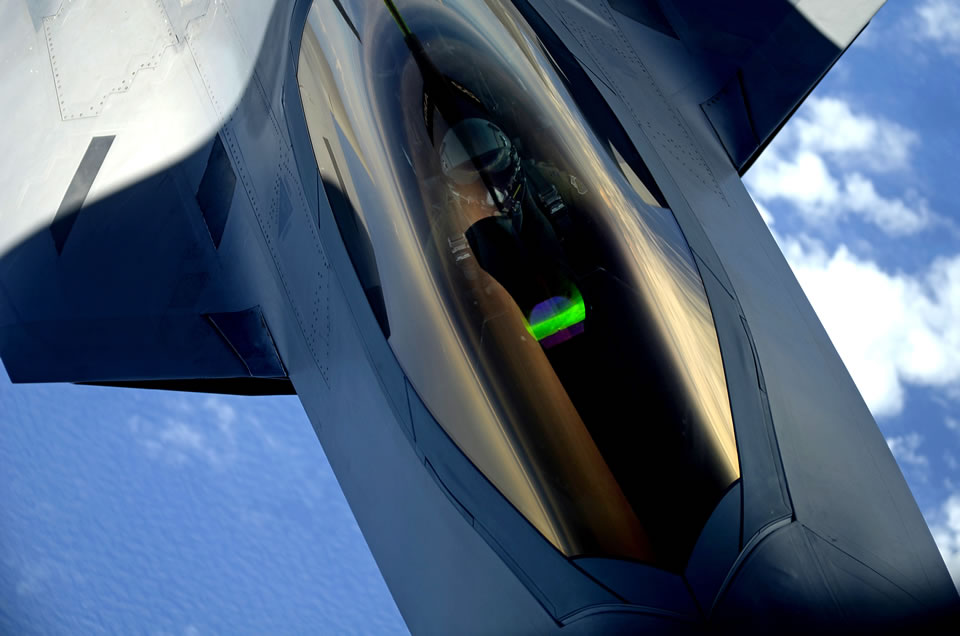

The US Air Force says its scientists have identified the root cause of the hypoxia-like events occured in its F-22A Raptor stealth fighters and linked it the supply of oxygen delivered to pilots, rather than the quality of oxygen the pilots are breathing. The Air Force is implementing two changes to correct the oxygen supply issue – removing a diagnostic filter to increasing the air flow and curb high altitude pressure suite, suspected to cause some of the problems. Air Force Secretary Michael B. Donley, Air Force Chief of Staff Gen. Norton A. Schwartz and other Air Force leaders briefed Defense Secretary Leon Panetta last week on this issue. Following the Air Force briefing last week, Panetta decided to lift restrictions on the aircraft gradually. Beginning today, F-22s may resume long-duration flights for deployments, aircraft deliveries and repositioning of aircraft.
As a more permanent solution, the vest will be modified by replacing a valve in the upper pressure garment vest worn by pilots during high-altitude missions. This valve inflates the vest at high altitude, but also cause the vest to remain inflated under conditions where it was not designed to do so, thereby causing breathing problems for some pilots. This garment has been suspended from flight since June 2012 with F-22 missions restricted to low-medium alttudes, where such garments are not required. These restrictions could be removed by early fall, following the testing of the modified upper pressure garment and completion of the Scientific Advisory Board recommendations, and NASA independent analysis. (The issue was described in details by Dave Majumdar on the DEW Line back in June 2012)
Increasing the volume of air flowing to pilots will be achieved by removing the diagnostic filter installed after the first reports on hypoxia incidents occured, to determine whether there were any contaminants present in the oxygen system. As Oxygen contamination was ruled out this filter is no longer needed. The Air Force is also exploring improving the oxygen delivery hose and its physical connections. The Air Force also plans to instal a new backup emergency oxygen system, along witha cockpit-mounted oxygen sensor and improved pilot oxygen sensor, all recommended by the NASA and Scientific Advisory Boards. To be on the safe side, the Air Force has surveyed F-22 pilots, and found “the vast majority have expressed confidence in the aircraft”…
The F-22 aircraft have flown more than 7,000 sorties, totaling more than 9,000 hours, since the last unexplained incident involving hypoxia-like symptoms occurred on March 8, 2012. Two incidents involving oxygen-related concerns since then were determined to be mechanical malfunctions, in other words, explained incidents. On June 26, an incident at Langley Air Force Base was caused by a faulty valve in the cockpit. On July 6, at Hickam Air Force Base, indicators in an F-22 signaled a possible oxygen problem, but the issue resolved itself in flight. In other words, these two incidents haven’t clarified why past ‘unexplained’ incidents occurred.
ince September 2011, at least five ground crew members working on the F-22 have also experienced hypoxia-like symptoms such as “dizziness, nausea and other signs of oxygen deprivation,” Brig. Gen. Daniel Wyman, surgeon general of Air Combat Command, told Air Force Times. But the maintenance workers don’t use the pilots’ breathing equipment or oxygen valve. According to the Air Force, the incidents experienced by the maintainers are not connected with the physiological incidents experienced by the pilots. “Because of the symptoms’ ambiguities, the deciding evidence was the absence of compounds in quantities capable of causing symptoms,” Air Force spokesperson Lt. Col. Edward T. Sholtis said, adding that the Air Force and outside experts tested and analyzed more than 2,000 samples. (POGO)
Nevertheless, the secretary has approved the Air Force planned sequence of actions to remove flight restrictions over time, after receiving assurances that these corrective measures would minimize hypoxia-like events in the aircraft. The F-22 has been flying under restrictions ordered by Secretary Panetta since May 15 of this year. These restrictions have limited the deployment of Raptors overseas. A unit of F-22A has been deployed in the UAE for some time, but a forward deployment to Japan has been delayed sofar. Following the decision to return to normal operations, Secretary Panetta has authorized the deployment of a squadron of F-22s to Kadena Air Base in Japan. The aircraft will fly to Japan under altitude restrictions via the North Pacific transit route. If all goes well on that flight, the Air Force will recommend resuming most long-duration flights.
As the altitude and range restrictions are still in effect, the Air Force is planning this trans-oceanic deployment to Japan with extreme caution. The planes will fly at lower altitude, which means that pilots won’t have to use the problematic upper garment vest. In addition, at anytime on their route aircraft will have to be within 30 minutes of a landing field (even when flying over the ocean).
Following the completion of these corrective actions and the installation of the backup oxygen system, the Air Force will request resumption of the aerospace alert control alert missions in Alaska. Until that time, this mission will continue to be flown by other aircraft.













